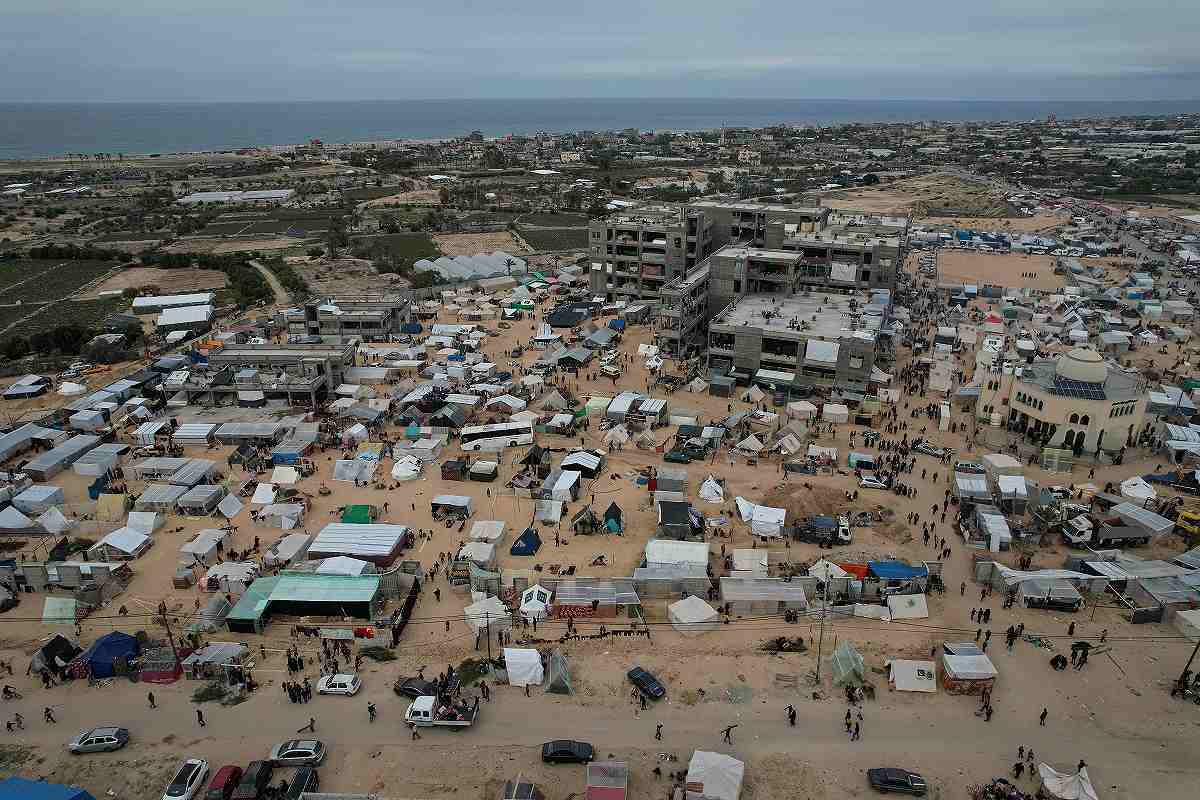
Displaced Palestinian families live in tents in the al-Mawasi area of Rafah in the Gaza Strip.
16:45 JST, December 16, 2023
Rafah is Gaza’s place of last resort.
Almost half of the enclave’s 2.2 million people have been squeezed into its southernmost city, home to 280,000 Palestinians before the war, according to the United Nations.
People cram into any space they can find: in a home still standing, an overflowing shelter or a tent in a makeshift camp. Others sleep on the cold streets.
In recent days, thousands more Gazans have fled to Rafah to escape Israel’s expanding southern offensive.
Israel has told civilians they will be safest near the Egyptian border.
But missiles still strike homes in Rafah. And the trickle of humanitarian goods coming into the city is not enough to stave off mass hunger and disease.
People wait days in line for a bag of flour. New arrivals can no longer find or afford to buy mattresses, food, tents, medicine and clothes. Diarrhea, respiratory diseases and skin infections are spreading.
There is nowhere left for people to move. And as bad as things are in Rafah, the greatest fear for many displaced Gazans is that they will eventually be forced out of the enclave for good.
Nearly 18,800 Palestinians have been killed and more than 50,000 injured, according to the Gaza Health Ministry, since Israel launched its assault nine weeks ago.
The war began on Oct. 7, when Hamas and allied militants stormed into southern Israel, killing 1,200 people and taking some 240 hostages.
“I have no answer to a father of five in Rafah who asked me how he and his children can survive on one can of beans for three days,” Philippe Lazzarini, the head of the U.N. Relief and Works Agency for Palestinian refugees, said Thursday.
He called the Gaza Strip “a living hell,” a place “on the verge of collapse.”
Rafah may endure fewer bombardments than other parts of Gaza – but strikes can still hit suddenly and without warning.
On Tuesday, Wael Harb, 49, said he was awakened at 3 a.m. by the sound of multiple explosions, targeting four homes in the al-Zuhur neighborhood just north of Rafah city. The force of the blast sent body parts onto nearby rooftops. Nearly two dozen people were killed, Harb told The Washington Post, among them eight children in his family.
Salah al-Jabari, a doctor at the Kuwaiti Hospital in Rafah, worries that people who have survived bombardments will now die of disease.
“The overcrowding in shelters is leading to the spreading of infectious diseases that we cannot control,” he told The Post. “The whole health system here collapsed. We need the help of all the governments all over the world to save those people.”
In Rafah, people pass the days waiting in lines, charging phones, caring for wounds, searching for basic necessities, keeping children calm – and trying not to dwell on all they’ve lost.
Ahmed Zahar, 30, lives in a tent in Rafah that can’t keep out the winter rain. He pitched it by the ruins of his family’s three-story home.
“There is no other option,” he said. “We want to live. We won’t leave our homes.”
"News Services" POPULAR ARTICLE
-

American Playwright Jeremy O. Harris Arrested in Japan on Alleged Drug Smuggling
-

Japan’s Nikkei Stock Average as JGB Yields, Yen Rise on Rate-Hike Bets
-

Japan’s Nikkei Stock Average Licks Wounds after Selloff Sparked by BOJ Hike Bets (UPDATE 1)
-

Japanese Bond Yields Zoom, Stocks Slide as Rate Hike Looms
-

Japan’s Nikkei Stock Average Buoyed by Stable Yen; SoftBank’s Slide Caps Gains (UPDATE 1)
JN ACCESS RANKING
-

Keidanren Chairman Yoshinobu Tsutsui Visits Kashiwazaki-Kariwa Nuclear Power Plant; Inspects New Emergency Safety System
-

Imports of Rare Earths from China Facing Delays, May Be Caused by Deterioration of Japan-China Relations
-

University of Tokyo Professor Discusses Japanese Economic Security in Interview Ahead of Forum
-

Japan Pulls out of Vietnam Nuclear Project, Complicating Hanoi’s Power Plans
-

Govt Aims to Expand NISA Program Lineup, Abolish Age Restriction





















